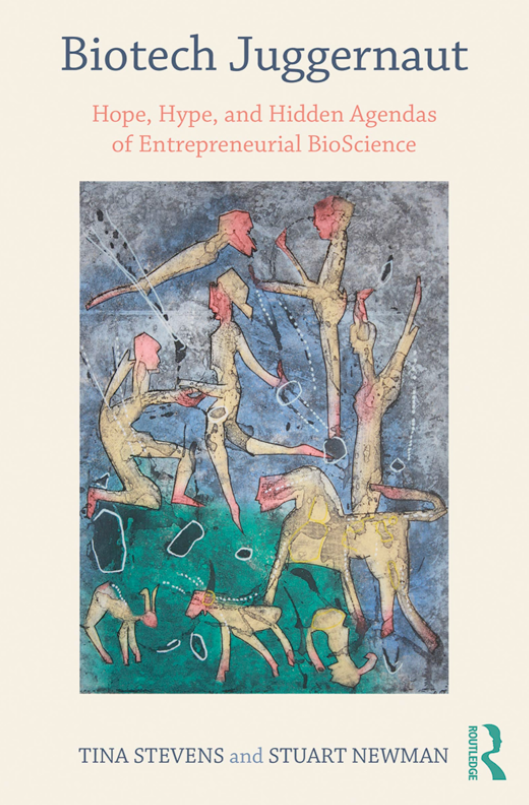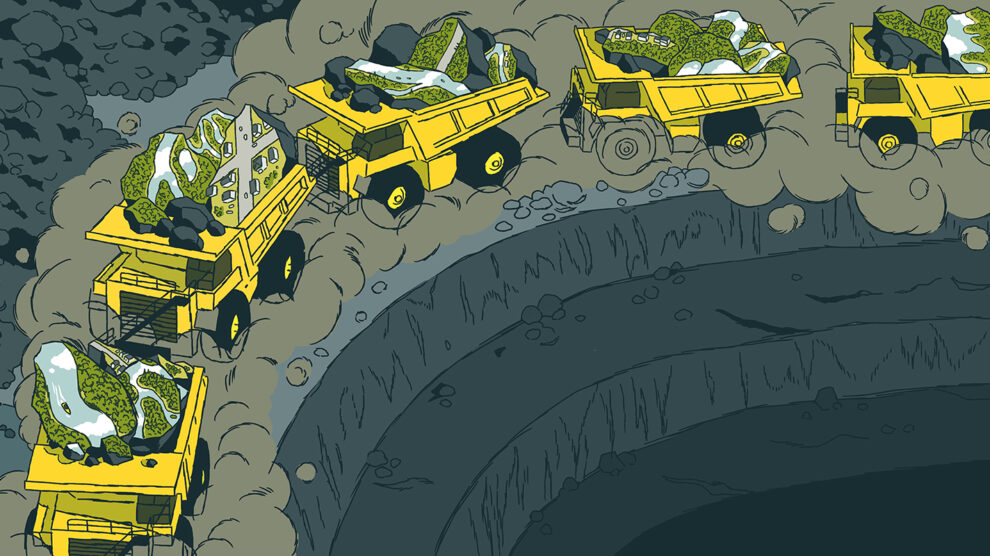A Biotechnology Crossroads
By Becca Muir
Volume 23, number 3, Bio-Politics

Before Tina Stevens and Stuart Newman wrote Biotech Juggernaut, Newman helped Stevens fight legal action from an unexpectedly powerful adversary. Two scientists and the financer-author of Proposition 71, a 2004 California state initiative to fund stem cell medicine and promising imminent cures, wanted to prevent Stevens expressing her “false and misleading” views about the bill. Advocates said Proposition 71 would lead to miracle treatments for serious, debilitating illnesses such as Alzheimer’s, multiple sclerosis and heart disease. Using DNA from a patient and an egg donated by a healthy woman, researchers would produce embryonic stem cells that could then specialise and replace virtually any cell in the patient’s body.
But, Stevens, a bioethicist and historian, felt uneasy about the scientific and ethical claims of the proposition. She was part of a progressive wing of activists who were concerned about the serious risks posed to women who donated eggs for this research, as well as the troubling ethical implications of some of the techniques used. The type of stem cell research proposed in the proposition constituted a form of human cloning – somatic cell nuclear transfer.
Stevens believed that the potential for human cloning technology was deliberately veiled by advocates. She wrote a rebuttal, outlining the medical and ethical issues that Californian voters should be aware of. A staffer from the Secretary of State’s office called only a few days later, warning Stevens that she was facing legal action. Someone was trying to block particular statements in the threesome’s rebuttal from appearing in the Voter’s Guide.
Searching for support, Stevens got in touch with Stuart Newman, a Professor of Biology at New York Medical College who had already testified before the US Congress about human cloning issues. Together, they defeated this lawsuit.
Winning this battle did not prevent Proposition 71 from passing. But it did leave Stevens and Newman with questions about why they had been so aggressively silenced. Why were bio-entrepreneurs gatekeeping conversations about stem cell medicine? Where were the regulations preventing abuses and misuses of applied biological research? And how did bioscience move away from “knowledge for knowledge’s sake,” and towards a market-based, profit-driven model?
Biotech Juggernaut aims to answer these questions and explore how historical, social, economic, and political forces have shaped biotechnology today. The book charts the history of genetic technology, the rise of the modern biotech industry, and the ways that once controversial advancements have been normalised.
—–
Genetic technology was not always met with such enthusiasm. Biologists in the 1960s and 1970s, Stevens and Newman argue, were more cognizant of the ethical implications of genetic technologies due to the recent legacy of the atomic bomb. The physicists involved in the development of nuclear weapons had failed to shield physics from ill use and vested political interests. Newman was no stranger to this legacy, as he began critiquing science during his graduate studies at the University of Chicago Department of Physics. The atomic bomb had been partly developed there as part of the Manhattan Project, creating a generation of concerned scientists, including originators of Science for the People. As he moved into the life sciences, Newman co-founded the Council for Responsible Genetics, and began considering the social implications of biotechnology.
Researchers involved in biotechnology now face unanticipated ethical challenges created by the commercialization of the discipline.The authors argue that research scientists themselves are corrupted by capitalism, due to the friction created when researchers produce knowledge for all while also producing wealth for themselves. They argue that, although not all scientists personally benefit financially from biotechnology, they are heavily incentivised to participate in this newly “entrepreneurial” culture. Rushing towards speculative cures is encouraged by commercial funders and, increasingly, the general public, who have been led to believe that biotechnology will produce certain cures for devastating illnesses.
The case of eighteen-year-old Jesse Gelsinger exemplifies how the grandiose promises of early gene therapies can have tragic consequences. Jesse had a mild form of a rare metabolic syndrome affecting liver function, which he controlled using a special diet and medication regime. He died after experiencing an inflammatory response to a viral vector used in an experimental gene therapy. It transpired that the lead researcher, Dr. James M. Wilson, had a serious conflict of interest: his biotech company had a financial stake in the outcome of the trial. Additionally, the researchers had concealed that two monkeys in the pretrial animal studies had died. The authors argue that “Jesse Gelsinger fell victim to a bioscience culture that largely ignored conflicts of interest, cutting corners in pursuit of pushing products to market.”
—-
In later chapters, the authors also argue that misleading language is used by those inside biotechnology to shape the dominant discourse and subtly influence public perceptions. False analogies and deliberate misrepresentation cloak how radical these technologies actually are, allowing normalization of these advancements.
A good example is mitochondrial replacement therapy. This treatment can help parents circumvent the risk of a child developing a mitochondrial disorder if the mother carries deleterious mitochondrial genes. A third person’s healthy mitochondrial DNA contributes towards the embryo’s mitochondrial development. A baby is produced using a donor egg that has had its nucleus removed and replaced by a nucleus obtained from a parent’s egg.
Proponents say that the third person has no genetic stake at all. Yet many scientists warned about how genetic elements from the donor could be passed onto the child, creating the first “three parent” babies. When the British government approved the procedure in 2015, the public were told it was “equivalent to changing a laptop battery.”1 Yet, as Stevens and Newman point out, no mitochondria are transferred or replaced in this procedure. In fact, it is the other way around: the nucleus is placed into the donor’s cellular environment, which then supports and influences the embryo’s development. Stevens and Newman argue that proponents encouraged deliberate misunderstandings to make each biotechnological advancement seem unworthy of concern. “Each time humanity eyed one of these biotechnologies it was standing at a crossroads. Each time, it could have stepped off the road to Gattaca – had the route underfoot not been determinedly disguised.”
In the final chapter, the authors leave us with a question: who should be forming our future? Although this book was published last year, the warnings about the insidious nature of biotechnological progress are becoming more relevant each day. COVID-19 has plunged the world into the worst recession since the 1930s, yet the biotechnology sector has become supercharged financially.2 Once again, we are standing at a crossroads in a technological revolution, and this time the world is hungry for a fix-all solution to the biggest global crisis faced in recent years. As the juggernaut of biotechnology pushes forward in the hope of addressing this new challenge, will ethical boundaries become even more blurred?
Biotech Juggernaut: Hope, Hype, and the Hidden Agendas of Entrepreneurial BioScience
Tina Stevens and Stuart Newman
Routledge
2019
218 pages
- Rebecca Muir, Alan Diot, and Joanna Poulton, “Mitochondrial Content Is Central to Nuclear Gene Expression: Profound Implications for Human Health,” BioEssays 38, no. 2 (2016): 150–56, https://doi.org/10.1002/bies.201500105.
- “COVID-19 to Plunge Global Economy into Worst Recession since World War II” (World Bank), accessed October 18, 2020, https://www.worldbank.org/en/news/press-release/2020/06/08/covid-19-to-plunge-global-economy-into-worst-recession-since-world-war-ii; Berkeley Lovelace Jr, “Biotech Stocks Surge as People Are ‘Hungry’ for Good News on the Coronavirus,” CNBC, April 17, 2020, https://www.cnbc.com/2020/04/17/biotech-stocks-surge-as-people-are-hungry-for-good-news-on-coronavirus.html





